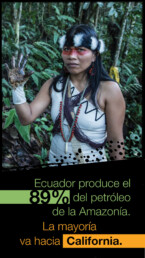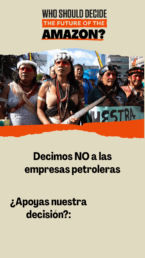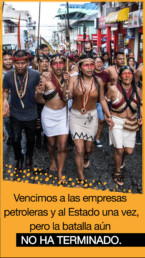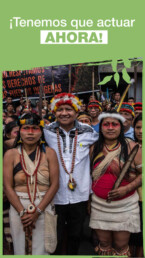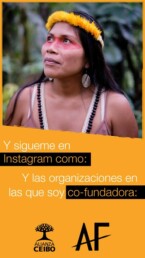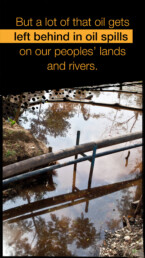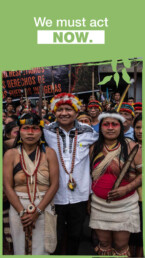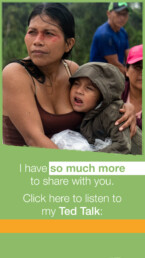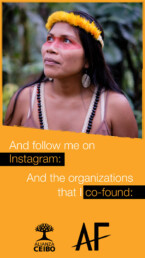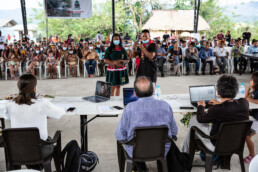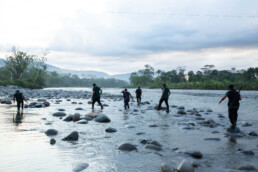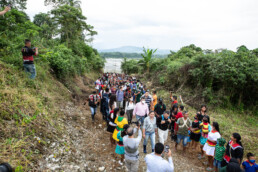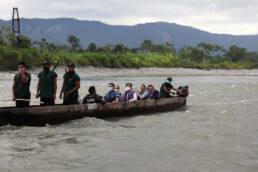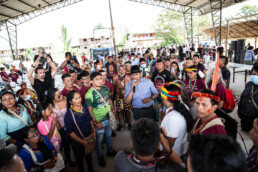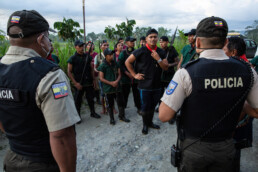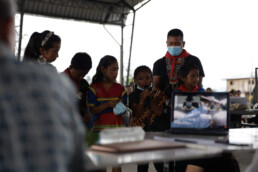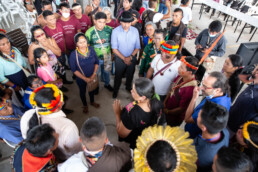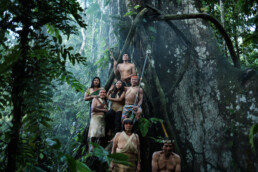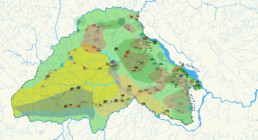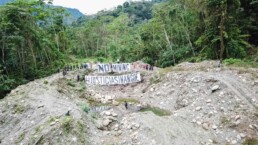Building power for Indigenous Guardianship in 2021
Building power for Indigenous Guardianship in 2021
It’s been a powerful year for Amazon Frontlines,the Ceibo Alliance and our Indigenous partners across the upper Amazon. In recognition of the challenges and in celebration of our achievements, we’re excited to share a quick look back at our impact in 2021.
The climate crisis is real: we’re experiencing its effects more and more each year. While world world leaders make underwhelming commitments to tackling climate change, Indigenous peoples are showing the world what climate action really looks like.
At Amazon Frontlines, we are battling the climate crisis by securing Indigenous Guardianship of the Amazon Rainforest. That means building the capacity, tools and support networks that Indigenous peoples need to keep the extractive companies out, keep their forests standing, and thrive in their territories for the long term. And we have big plans for 2022!
Our work and our achievements would not be possible without the generous support of our community. As we approach the end of 2021, we’d like to ask you to dig deep and give whatever you can to support Indigenous climate action on the frontlines.
And if you donate before the end of the year, a generous core supporter has offered to match all gifts up to $20,000 online grassroots !!
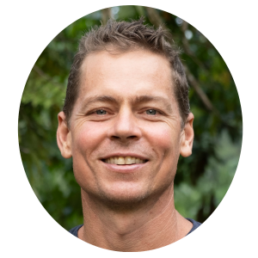
Mitch Anderson
Leonardo DiCaprio y Nemonte Nenquimo unen fuerzas
Sintoniza directamente con la sabiduría de la líder indígena y recientemente oradora de la charla TED Climate Countdown, Nemonte Nenquimo, a través de un Instagram Takeover en exclusiva por la cuenta de Leonardo DiCaprio.
A lo largo del Instagram Takeover, Nemonte nos guiará en un viaje a la Amazonía y a su hogar en el territorio Waorani, con narraciones directas, videos y fotos personales. El relato de Nemonte también es un llamado a la acción, que nos invita a amplificar su historia y a apoyar a los defensores indígenas en la primera línea.
Los Waorani ganaron una victoria legal histórica en contra de las grandes petroleras en 2018. Desde entonces, Nemonte ha continuado la lucha para evitar que la industria petrolera siga destruyendo la selva que ella ama. Hoy, el gobierno ecuatoriano está amenazando con DUPLICAR la extracción de petróleo y la minería en la Amazonía.
También puedes seguir a Nemonte en su Instagram @nemonte.nenquimo y a las organizaciones que ella co-fundó: @amazonfrontlines @alianzaceibo
Leonardo DiCaprio and Nemonte Nenquimo Join Forces
Tune in directly to the wisdom of Indigenous leader and recent TED Climate Countdown speaker Nemonte Nenquimo through an Instagram takeover exclusively on Leonardo DiCaprio’s page.
Throughout the Instagram takeover, Nemonte will lead us on a journey into the Amazon rainforest and her home in Waorani territory with on-the-ground storytelling and personal videos and photos. Nemonte’s account is also a call to action, inviting us to amplify her story and support Indigenous defenders on the frontlines.
The Waorani people won a landmark legal victory against Big Oil in 2018. Since then, Nemonte has continued to fight to keep the oil industry from destroying the rainforest that she loves. Today, the Ecuadorian government is threatening to DOUBLE oil and mining in the Amazon.
You can also follow Nemonte on Instagram @nemonte.nenquimo AND the organizations that she co-founds @amazonfrontlines @alianzaceibo
Report: Rights Defenders Under Threat in Ecuador
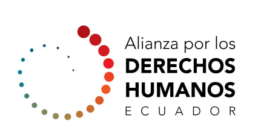
The Alliance for Human Rights in Ecuador released a report revealing the intensifying dangers that rights defenders face as part of their struggles to protect and defend their territories, autonomy, and identity, and shining a spotlight on government and industry complicity to undermine their vital work. It was delivered to government authorities and the Ombudsman’s Office on the critical situation of rights defenders in the country.
The report, published by a coalition of nineteen human rights organizations, including Amazon Watch, maps systematic rights violations against rights defenders including intimidation, threats, harassment, prosecution, persecution, and even assassinations, committed principally by the armed forces, national police, and public officials. Through the documentation of twenty-two emblematic cases from the Amazon to the Andes and the coast, the report exposes the experience of 449 rights defenders over the last decade. Three assassinations linked to the mining sector notably continue with impunity.
The work of human rights and environmental defenders in Ecuador, one of the world’s most biodiverse countries, is vital to the protection of critical natural ecosystems such as the Amazon rainforest and fundamental for the protection of democracy and the rule of law. Oil, mining, agribusiness, and the water sector are consistently the biggest drivers of attacks against rights defenders.
With Ecuador’s new government set to ramp up natural resource extraction in the context of the global economic crisis of the pandemic and the country’s crippling debt to China and the International Monetary Fund, this worrisome trend risks only intensifying.
Desde el corazón de la Amazonía: una batalla sobre quiénes deciden el futuro de los ríos y los bosques ante la Corte Constitucional
El 15 de noviembre de 2021, pocos días después de que finalizara la conferencia climática COP26, el movimiento Indígena de Ecuador recibió a jueces del tribunal más alto del país, para una audiencia histórica en lo profundo del territorio indígena amazónico, por primera vez en la historia de Ecuador. Líderes indígenas de todo el país, así como funcionarios estatales (anteriormente demandados), presentaron sus argumentos orales ante la Corte que busca sentar un precedente nacional sobre quizás, los dos derechos más importantes para la gobernanza Indígena sobre la selva tropical más grande de nuestro planeta.
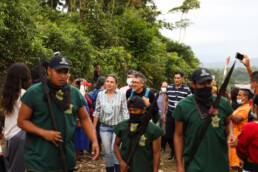
Como se detalla en el comunicado publicado ayer por el Movimiento Indígena de Ecuador, el caso se refiere en primer lugar, “al derecho de los pueblos indígenas del Ecuador a decidir lo que sucede en nuestros territorios, es decir, nuestro derecho esencial a la autodeterminación y consentimiento previo, libre e informado, reconocido internacionalmente pero no así reconocido, respetado o aplicado en Ecuador”. Y segundo, “los Derechos de la Naturaleza, es decir, el derecho de los ríos, bosques, montañas y animales a existir sin amenazas, contaminación o destrucción”. Con el 70% de la Amazonía ecuatoriana en manos indígenas, y un nuevo presidente, exbanquero y conservador que promete duplicar la producción de petróleo y expandir rápidamente la minería en la Amazonía, este fallo podría determinar el futuro.
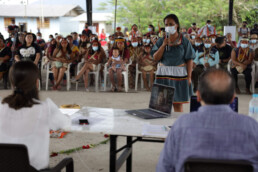
Esta importante audiencia tuvo lugar en la comunidad A’i Cofan de Sinangoe, cuya victoria en el 2018 frente a un tribunal, canceló 52 concesiones de extracción de oro a lo largo de una de las cuencas acuíferas amazónicas más importantes del país. Los A’i Cofán, un grupo indígena conocido por sus habilidades de sanación, de navegación fluvial y administración de uno de los ecosistemas con mayor biodiversidad en Ecuador, acogió a cientos de líderes indígenas, ancianos y jóvenes de todo el país con un claro mensaje: “Nuestro territorio es la base de nuestra propia existencia y como pueblos ancestrales tenemos derecho a decidir sobre nuestro futuro y nuestros territorios”.
Su territorio es de 63.775 hectáreas de bosque primario, donde viven jaguares, osos andinos y tapires. “nuestros espíritus y la ‘gente invisible’ viven también allí, es donde reside nuestra identidad como Pueblo y solo allí se puede vivir, pensar y ser A’i Cofán”.
Cinco de los nueve jueces de la Corte cruzaron el río Aguarico y participaron en una ceremonia tradicional de armonización antes de conectarse vía internet satelital, e iniciar la audiencia de forma oficial. De parte del Estado ecuatoriano, el Ministerio de Energía y Recursos Naturales No Renovables estuvo presente en Sinangoe para defender la extracción de metales y petróleo en territorios indígenas para promover “la riqueza y el progreso de todos”. Otros Ministerios, como el Ministerio de Ambiente, Agua y Transición Ecológica, participaron en la audiencia en línea.
Líderes de todo el país, especialmente de la Amazonía, viajaron a la audiencia para presentar un frente unificado contra el extractivismo en sus territorios sin su consentimiento. Los líderes indígenas presentaron escritos y testimonios ante la Corte, detallando una larga y sistemática historia de violaciones de derechos.
Wider Gauramag, coordinador de la guardia indígena de Sinangoe en la foto de arriba en coordinación con la escolta policial de la Corte, explicó a los jueces que “como pueblos ancestrales de estos territorios, como pueblos milenarios, tenemos derecho a ser consultados, pero también que nuestro consentimiento sea el objetivo último de esa consulta. Si decimos que sí, así será, si decimos que no, eso significa que no. Nosotros defendemos la vida, defendemos nuestro territorio”.
Los niños de la comunidad entregaron dibujos y cartas a los jueces como evidencia.
Tayra Narváez, una niña A’i Cofán de 12 años, dijo a los jueces: “Quiero que nos escuchen porque a los niños este territorio nos lo da todo y somos felices. Necesitamos que cuiden nuestro territorio, para que podamos vivir sin minería y sin contaminación”.
Nemonte Nenquimo, representando a los Waorani de Pastaza y cuyo histórico caso también será escuchado por la Corte Constitucional dijo a los jueces:
“Tienen una gran oportunidad como jueces. Queremos que se respete nuestro derecho a decir sí o no a los proyectos extractivos. Lo que ha sucedido hasta ahora solo ha llevado al engaño, la división y la destrucción. Como mujeres, exigimos que se respeten nuestros derechos. Estaremos al frente de esta lucha porque sabemos que una gran amenaza para nuestros territorios está en el horizonte”.

Nemonte Nenquimo, representando a los Waorani de Pastaza y cuyo histórico caso también será escuchado por la Corte Constitucional dijo a los jueces:
“Tienen una gran oportunidad como jueces. Queremos que se respete nuestro derecho a decir sí o no a los proyectos extractivos. Lo que ha sucedido hasta ahora solo ha llevado al engaño, la división y la destrucción. Como mujeres, exigimos que se respeten nuestros derechos. Estaremos al frente de esta lucha porque sabemos que una gran amenaza para nuestros territorios está en el horizonte”.

José Gualinga, ex presidente de los Kichwa de Sarayaku explicó a los jueces que:
“explotar nuestros territorios sagrados es como minar en las antiguas ruinas de Roma o en Notre Dame en París”.
José Gualinga, ex presidente de los Kichwa de Sarayaku explicó a los jueces que:
“explotar nuestros territorios sagrados es como minar en las antiguas ruinas de Roma o en Notre Dame en París”.
Wiña Omaka, una anciana Waorani, estuvo acompañada de otras mujeres mientras cantaba para los jueces.
“Nuestra tierra lo es todo. Para nosotros y para ustedes. Allá lo tenemos todo. Peces, animales, medicinas. Se come del mercado de la ciudad, se come del bosque”.
Ella agregó:
“Cuando decimos ‘no’, eso significa que no. Yo soy la autoridad de mi territorio, como ustedes son las autoridades de la ciudad “.
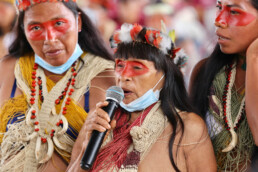
Wiña Omaka, una anciana Waorani, estuvo acompañada de otras mujeres mientras cantaba para los jueces:
“Nuestra tierra lo es todo. Para nosotros y para ustedes. Allá lo tenemos todo. Peces, animales, medicinas. Se come del mercado de la ciudad, se come del bosque”.
Ella agregó:
“Cuando decimos ‘no’, eso significa que no. Yo soy la autoridad de mi territorio, como ustedes son las autoridades de la ciudad “.
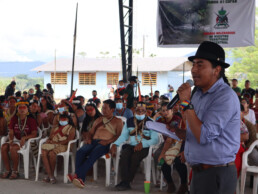
Leonidas Iza, presidente de la Confederación de Nacionalidades Indígenas del Ecuador, CONAIE, destacó la necesidad de garantizar el derecho al consentimiento previo, libre e informado para que los pueblos indígenas puedan ejercer la libre determinación y otros derechos fundamentales garantizados en la Constitución.
Leonidas Iza, presidente de la Confederación de Nacionalidades Indígenas del Ecuador, CONAIE, destacó la necesidad de garantizar el derecho al consentimiento previo, libre e informado para que los pueblos indígenas puedan ejercer la libre determinación y otros derechos fundamentales garantizados en la Constitución.
Justino Piaguaje dijo:
“De mi Nación, los Siekopai, solo quedan 600 personas aquí en Ecuador. Queremos seguir existiendo, y no caer en extinción como tantas otras culturas indígenas en la historia.
Debemos tener derecho a decidir sobre nuestro futuro y debemos garantizar los Derechos de la Naturaleza. Porque no es solo mi gente la que se enfrenta a la extinción: el mundo se enfrenta a un cambio climático profundo y a un punto de no retorno”.
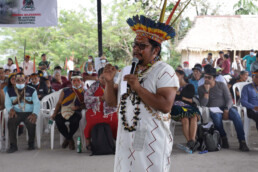
Justino Piaguaje dijo:
“De mi Nación, los Siekopai, solo quedan 600 personas aquí en Ecuador. Queremos seguir existiendo, y no caer en extinción como tantas otras culturas indígenas en la historia.
Debemos tener derecho a decidir sobre nuestro futuro y debemos garantizar los Derechos de la Naturaleza. Porque no es solo mi gente la que se enfrenta a la extinción: el mundo se enfrenta a un cambio climático profundo y a un punto de no retorno”.
Ecuador se convirtió en el primer país en consagrar los Derechos de la Naturaleza dentro de su Constitución en el año 2008, dando a los ciudadanos la posibilidad de demandar en nombre de árboles, ríos o animales. Este caso presenta una oportunidad para que la Corte Constitucional reconozca, entre otras cosas, cómo los derechos de un ecosistema fluvial frágil triunfan sobre los planes gubernamentales de minería o petróleo que podrían destruir ese río.
La abogada A’i Cofán de, María Espinosa, de Amazon Frontlines, argumentó ante la Corte que el historial de violaciones sistemáticas de derechos de parte del gobierno muestra que “la práctica actual de consultar a las comunidades indígenas frente a proyectos extractivos, pero sin reconocer su derecho a decir “no” viola sus derechos a la autodeterminación” Y pone a muchos en riesgo de exterminio físico y cultural.

Como dice ayer el comunicado publicado ayer por la comunidad Sinangoe y el Movimiento Indígena de Ecuador, “La resolución de este caso por parte de la Corte Constitucional es urgente y sumamente importante para el momento en que se encuentra Ecuador y el planeta”.
La audiencia se llevó a cabo días después de que los líderes mundiales firmaran acuerdos para enfrentar el cambio climático, y detener la deforestación en la COP26 en Glasgow, y meses después de que el presidente de Ecuador, Guillermo Lasso, prometiera duplicar la extracción de petróleo y expandir rápidamente la actividad minera en la Amazonía, a través de los Decretos Presidenciales 95 y 151. (que fueron recientemente impugnados por los pueblos indígenas en la Corte)”.
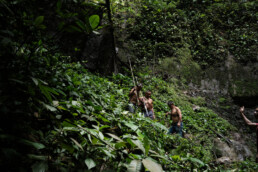
“Los pueblos indígenas cuidan el 70% de la Amazonía ecuatoriana, casi 7 millones de hectáreas de la selva tropical más importante del planeta. La deforestación de solo una hectárea de nuestros territorios representaría las emisiones de carbono equivalentes a 160 automóviles durante todo un año.
No es posible enfrentar el cambio climático sin la Amazonía, y no es posible proteger la Amazonía sin nosotros, los pueblos indígenas, y sin garantizar nuestros derechos”.
Cuando los jueces interrumpieron la audiencia, los líderes indígenas tomaron medidas inmediatas, instalando una Asamblea General en el lugar para seguir escuchando los testimonios. La Asamblea resolvió mantenerse en vigilancia constante hasta que la Corte publique un fallo, y exhortó al gobierno nacional a congelar todas las concesiones o licencias futuras para las industrias extractivas hasta que la Corte decida.
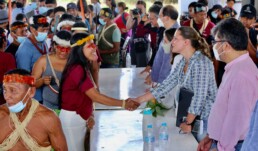
La Corte debería publicar un fallo dentro de los próximos meses, que sentará un precedente nacional. La sentencia también sentará un precedente obligatorio para la Asamblea Nacional de Ecuador, quienes deberá elaborar una ley que regule el derecho al consentimiento previo, libre e informado a nivel nacional.
Los jueces de la Corte Constitucional tienen la gran responsabilidad de tomar una decisión sobre nuestros derechos. Se trata de vida o muerte, de nuestro futuro o de nuestra extinción.
La Corte debería publicar un fallo dentro de los próximos meses, que sentará un precedente nacional. La sentencia también sentará un precedente obligatorio para la Asamblea Nacional de Ecuador, quienes deberá elaborar una ley que regule el derecho al consentimiento previo, libre e informado a nivel nacional.
Los jueces de la Corte Constitucional tienen la gran responsabilidad de tomar una decisión sobre nuestros derechos. Se trata de vida o muerte, de nuestro futuro o de nuestra extinción.
From the Heart of the Amazon: A Supreme Court Battle Over Who Decides the Future of the Rivers and Forests
On November 15th 2021, just days after the COP26 climate conference ended, Ecuador’s Indigenous movement hosted judges from the country’s highest court for a historic hearing deep in Indigenous Amazonian territory, a first in Ecuadorian history. Indigenous leaders from across the nation, as well as government officials (opponents in the original case), presented oral arguments as the Court looks to set national precedent on perhaps the two most important rights for Indigenous guardianship of our planet’s largest rainforest.

As detailed in a communication published yesterday by Ecuador’s Indigenous Movement, the case concerns first, “the right for Indigenous peoples in Ecuador to decide what happens in our territories, that is to say our essential right to self-determination and Free, Prior and Informed Consent, recognized internationally but not yet recognized, respected or applied in Ecuador.” And second, “the Rights of Nature, that is to say, the right of rivers, forests, mountains, and animals to exist without threats, contamination or destruction.” With 70% of the Ecuadorian Amazon in Indigenous hands and a new conservative ex-banker President promising to double oil production and rapidly expand mining in the Amazon, this ruling could be a game-changer.

The high-stakes hearing took place in the A’i Kofan community of Sinangoe, whose 2018 lower-court victory canceled 52 gold-mining concessions along one of the country’s most important Amazonian headwaters. The A’i Kofán, a legendary Indigenous group known for their healing powers, river navigation skills, and stewardship of one of the most bio-diverse ecosystems in Ecuador, hosted hundreds of Indigenous leaders, elders and youth from across the country with a clear message: “Our territory is the base of our very existence and as ancestral peoples we have the right to decide over our future and our territories.”
Their territory is 63,775 hectares of primary forest, where jaguars, spectacled bears, and tapirs live. “Our spirits and the ‘invisible people’ live there too, it is where our identity as a People resides and only there is it possible to live, think and be A’i Kofán.”
Five of the nine judges of the Court crossed the Aguarico River and participated in a traditional harmonization ceremony before connecting to satellite internet and initiating the official hearing. From the Ecuadorian state, the Ministry of Energy and Mining was present in Sinangoe to defend the extraction of metals and petroleum in Indigenous territories to promote “the wealth and progress of everyone.” Other Ministries, like the Ministry of the Environment, Water and Ecological Transition, participated in the hearing online.
Wider Gauramag, Coordinator of the Indigenous guardia of Sinangoe pictured above in coordination with the Court’s police escort, explained to the judges that “as ancestral peoples of these territories, as millenary peoples, we have the right to be consulted but also that our consent is the ultimate objective of that consultation. If we say yes, that’s how it will be, if we say no, then that means no. We defend life, we defend our territory.”
Children from the community handed in drawings and hand-written letters to the judges as evidence.
Tayra Narvaez, a 12 year-old A’i Kofán girl, told the judges, “I want you to listen to us because as children this territory gives us everything and we are happy. We need you to take care of our territory, so we can live without mining and without contamination.”
Nemonte Nenquimo, who represents the Waorani of Pastaza and whose historic court case will also be heard by the Supreme Court shortly, said to the judges:
“You have a great opportunity as judges. We want our right to say yes or no to extractive projects to be respected. What has happened up until now has only led to deceit, division and destruction. As women, we demand that our rights are respected. We will be at the frontlines of this fight because we know that a great threat to our territories is on the horizon.”

Nemonte Nenquimo, who represents the Waorani of Pastaza and whose historic court case will also be heard by the Supreme Court shortly, said to the judges:
“You have a great opportunity as judges. We want our right to say yes or no to extractive projects to be respected. What has happened up until now has only led to deceit, division and destruction. As women, we demand that our rights are respected. We will be at the frontlines of this fight because we know that a great threat to our territories is on the horizon.”

Jose Gualinga, ex-President of the Kichwa of Sarayaku explained to the judges that:
“mining in our sacred territories is like mining in the ancient ruins of Rome or the Notre Dame in Paris.”
Jose Gualinga, ex-President of the Kichwa of Sarayaku explained to the judges that:
“mining in our sacred territories is like mining in the ancient ruins of Rome or the Notre Dame in Paris.”
Wiña Omaka, a Waorani elder, was joined by other women as she sang to the judges:
“Our land is everything. For us and for you. There we have everything. Fish, animals, medicine. You eat from the market in the city, we eat from the forest.”
She added:
“When we say ‘no’ that means no. I am the authority of my territory, as you are the authorities in the city.”

Wiña Omaka, a Waorani elder, was joined by other women as she sang to the judges:
“Our land is everything. For us and for you. There we have everything. Fish, animals, medicine. You eat from the market in the city, we eat from the forest.”
She added:
“When we say ‘no’ that means no. I am the authority of my territory, as you are the authorities in the city.”

Leonidas Iza, President of the national Indigenous federation CONAIE, stressed the need to guarantee the right to free, prior and informed consent in order for Indigenous peoples to exercise self-determination and other fundamental rights guaranteed in the Constitution.
Leonidas Iza, President of the national Indigenous federation CONAIE, stressed the need to guarantee the right to free, prior and informed consent in order for Indigenous peoples to exercise self-determination and other fundamental rights guaranteed in the Constitution.
Justino Piaguaje said:
“My Nation, the Siekopai, have only 600 people left here in Ecuador. We want to continue to exist, and not fall into extinction like so many other Indigenous cultures in history.
We must have the right to decide our future and we must guarantee the Rights of Nature. Because it’s not just my people that face extinction: the world is facing profound climate change, and a point-of-no-return.”

Justino Piaguaje said:
“My Nation, the Siekopai, have only 600 people left here in Ecuador. We want to continue to exist, and not fall into extinction like so many other Indigenous cultures in history.
We must have the right to decide our future and we must guarantee the Rights of Nature. Because it’s not just my people that face extinction: the world is facing profound climate change, and a point-of-no-return.”
Ecuador became the first country to enshrine the Rights of Nature into its Constitution in 2008, giving citizens the possibility to sue on behalf of trees, rivers or animals. This case presents an opportunity for the Constitutional Court to recognize, among other things, how the rights of a fragile river ecosystem trump government plans for mining or oil that could destroy that river.
Sinangoe’s lawyer Maria Espinosa of Amazon Frontlines, argued to the Court that the government’s history of systematic rights violations show that “the current practice of consulting Indigenous communities before extractive projects but not recognizing their right to say “no” violates their right to self-determination” and puts many at risk of physical and cultural extermination.

As Sinangoe and Ecuador’s Indigenous Movement’s published statement yesterday says, “The resolution of this case by the Constitutional Court is urgent and extremely important for the moment that Ecuador, and the planet, currently finds itself in.
The hearing took place days after world leaders signed agreements to face climate change and stop deforestation at COP26 in Glasgow, and months after the President of Ecuador Guillermo Lasso promised to double oil extraction and rapidly expand mining in the Amazon, through Presidential Decrees 95 and 151 (which was recently challenged by Indigenous peoples in Court).”

Indigenous peoples take care of 70% of the Ecuadorian Amazon, almost 7 million hectares of the most important rainforest on the planet. Deforestation of just one hectare of our territories represents the equivalent carbon emissions of 160 cars for a whole year.
It is not possible to face climate change without the Amazon, and it is not possible to protect the Amazon without us, Indigenous peoples, and without guaranteeing our rights
When the judges cut the hearing short, Indigenous leaders took immediate action, installing a General Assembly on-site to continue listening to testimonies. The Assembly resolved to maintain in constant vigilance until the Court publishes a ruling and called on the national government to freeze all future concessions or licences for extractive industries until the Court rules.

The Court should publish a ruling within the next few months that will set national precedent. The ruling will also set obligatory precedent for Ecuador’s Congress which must elaborate a law that regulates the right to free, prior and informed consent nationally.
The judges of the Constitutional Court have the heavy responsibility to make a decision regarding our rights. This is about life and death, about our future or our extinction.
The Court should publish a ruling within the next few months that will set national precedent. The ruling will also set obligatory precedent for Ecuador’s Congress which must elaborate a law that regulates the right to free, prior and informed consent nationally.
The judges of the Constitutional Court have the heavy responsibility to make a decision regarding our rights. This is about life and death, about our future or our extinction.
Nuestro Territorio, Nuestra Decisión

15 de noviembre, Comunidad A’i Kofán de Sinangoe, Ecuador – Nosotros hacemos este comunicado desde nuestro territorio ancestral donde están enterrados los huesos de nuestros ancestros, donde habitan nuestros espíritus, y donde nosotros vivimos en armonía con la naturaleza – cosechando frutas de la selva, sembrando yuca y plátano en nuestras chacras, curandonos con plantas medicinales, y gozando y conviviendo con los ríos que salen desde las montañas selváticas que nosotros hemos venido protegiendo con lanzas por miles de años.
Hoy, es un día histórico para los pueblos indígenas del Ecuador porque es la primera vez que la Corte Constitucional ha cumplido su obligación de venir a nuestros territorios para entender nuestra forma de autodeterminación, nuestra cosmovisión, nuestra relación con el territorio, nuestra cultura, nuestra forma de tomar decisiones colectivas, y sentir el espíritu de nuestra lucha para defender la vida contra las amenazas imparables que vienen desde hace siglos, y que ahora se expresan en la minería, en el petróleo, las madereras y las hidroeléctricas. Este hecho no debe ser excepcional, acercarse a los territorios debe ser el actuar de las autoridades de justicia.
La audiencia que se mantuvo hoy día en nuestra comunidad se trata de dos cosas muy importantes: el derecho de los pueblos Indígenas de Ecuador de decidir sobre sus territorios, es decir nuestro derecho esencial a la autodeterminación y al Consentimiento Libre, Previo e Informado, un derecho reconocido a nivel internacional, pero todavía no reconocido, respetado ni aplicado en el Ecuador; y los derechos de la naturaleza, es decir, el derecho que tienen los ríos, los bosques, las montañas, las lagunas de existir sin amenaza, sin contaminación, sin destrucción.
Los jueces y juezas de la Corte Constitucional tienen una alta responsabilidad para decidir a partir de Sinangoe sobre nuestros derechos, se trata de la vida y la muerte, se trata de nuestro futuro o nuestra desaparición; después de haber escuchado docenas de testimonios de nuestros mayores, nuestros líderes, nuestros jóvenes, tienen en su manos la oportunidad y la obligación de pronunciarse con los más altos estándares sobre nuestro derecho a la autodeterminación, piedra angular para el ejercicio de nuestros derechos, e imprescindiblemente vinculados con el, nuestro derecho al territorio y a la consulta y consentimiento previo, libre e informado.
Estamos aquí con más de 300 representantes Indígenas de todo Ecuador, especialmente amazónicos, que han compartido la lucha por sus territorios y que hoy también tienen casos pendientes de resolver por la Corte Constitucional como los Waorani de Pastaza, Kichwas del cantón Santa Clara, Kichwas de Sarayaku, y otras nacionalidades, unidos por la misma petición, nuestro territorio es la base para nuestra existencia y como pueblos ancestrales nosotros tenemos el derecho a decidir sobre nuestro futuro y el de nuestro territorio. E igualmente nuestro rol esencial para la protección de los derechos de la naturaleza.
Cinco de los nueve jueces de la Corte cruzaron el Río Aguarico en la madrugada y fueron recibidos por las autoridades indígenas para instalar la audiencia presencial y on line. De parte del estado, el Ministerio de Energía y Minas estuvo presente para defender la extracción minera y petrolera en territorios indígenas para promover “la riqueza y el progreso para todos”, mientras que otros entidades estatales como el Ministerio del Ambiente, Agua y la Transición Ecológica, la Agencia de Control y Regulación Minero, y la Procuraduría General del Estado, no vinieron a nuestro territorio y prefirieron participar a través de una pantalla, pretendiendo como siempre justificar su actuación omisa, lesiva y violatoria de derechos.
Recordamos que nuestro caso inició en el 2018 cuando Sinangoe descubrió que sin consulta ni consentimiento el estado otorgó 20 concesiones mineras y estaba en proceso para entregar 32 más en la cabecera del Río Aguarico. Nuestra comunidad A’i Kofán de Sinangoe inicio un proceso de demanda constitucional en contra de cuatro ministerios y agencias del estado y en octubre de 2018, los jueces provinciales de Sucumbios nos dieron definitivamente la razón y ordenaron la reversión de las 52 concesiones mineras; reconociendo la violación de nuestros derechos y el grave riesgo para la superviviencia de nuestra comunidad que esta minería suponía. Una victoria histórica para nuestra comunidad y para todos los pueblos indígenas del Ecuador. Ahora, la Corte Constitucional tiene en sus manos nuestro caso para dejar un precedente nacional de cumplimiento obligatorio para el estado en relación con todos los pueblos y nacionalidades indígenas del país.
Durante la audiencia, los jueces escucharon los testimonios de nuestros hombres, mujeres, niños y niñas de la comunidad A’i Kofán de Sinangoe. Wider Guaraman, Coordinador de la Guardia Indigena de Sinangoe, explicó a los jueces que “Como ancestrales en estos territorios, como pueblos milenarios, tenemos ese derecho a ser consultados pero que sepan escuchar como último fin nuestro consentimiento. Si la comunidad dice sí, así será, y si decimos no, así será. La sentencia que ustedes escriban no solo va a servir para Sinangoe si no para muchos pueblos indígenas. Defendemos la vida. Defendemos nuestro territorio.”
Niños y niñas de la comunidad entregaron dibujos y cartas a los jueces. Tayra Narvaez, de 12 años, dijo, “Quisiera que me escuchen porque como niños en este territorio tenemos todo y estamos felices. Necesitamos que cuiden nuestro territorio y que podamos vivir sin minería y sin contaminación.”
Los A’i Kofán de Sinangoe somos un pueblo pescador, cazador y recolector, íntimamente relacionado con nuestro territorio, conocidos como grandes tomadores de yagé (ayahuasca). Nuestro territorio son 63,775 hectáreas de bosque primario, donde viven jaguares, osos anteojos y el tapir. Ahí viven nuestros espíritus y los que llamamos “la gente invisible”, ahí está nuestra identidad como pueblo y solo ahí es posible vivir, ser y pensar como A’i Kofán.
También intervinieron líderes de la nacionalidad Siekopai, la nacionalidad Sapara, el Pueblo Kichwa de Sarayaku, el Pueblo Kichwa de Santa Clara, el Pueblo Kichwa-Siona del Río Putumayo y organizaciones indígenas como la CONAIE (Confederación de Nacionalidades Indígenas del Ecuador), CONFENIAE (Confederación de Nacionalidades Indígenas de La Amazonia Ecuatoriana), CONCONAWEP (Consejo de Coordinación de la Nacionalidad Waorani de Pastaza), PAKKIRU (Pastaza Kikin Kichwa Runakuna ), PSHA (Pueblo Shuar Arutam), y FENASH-P (Federacion de la Nacionalidad Shuar de Pastaza), entre otras, quienes presentaron sus amicus ante los jueces, manifestando las mismas vulneraciones a sus derechos. La reconocida lideresa Nemonte Nenquimo, cuya organización representa a los waorani de Pastaza cuyo caso también fue seleccionado por la Corte Constitucional, manifestó ante los jueces: “Ustedes jueces tienen una gran oportunidad. Queremos que hagan una consulta con consentimiento. No se puede engañar nuestro derecho a la vida, la consulta solamente lleva a la división y destrución. Como mujeres, exigimos que se respeten nuestros derechos. Vamos a estar de pie de lucha porque sabemos que llega una gran amenaza a nuestros territorios”. José Gualinga, ex-Presidente del Pueblo Originario Kichwa de Sarayaku explicó a los jueces, “Minar en nuestros territorios sagrados es como ir a minar las iglesias del vaticano en Roma o el Notre Dame en París.”
La resolución de este caso por la Corte Constitucional es urgente y de suma importancia por el momento que vive el Ecuador y el planeta. Ocurre días después de que líderes de todo el mundo firmaron acuerdos para enfrentar el cambio climático en la COP26 en Glasgow, y meses después de que el Presidente del Ecuador Guillermo Lasso ha decidido duplicar la explotación petrolera del país y rápidamente expandir la frontera minera en la Amazonía a través de los Decretos 95 y 151. Los pueblos indígenas cuidamos el 70% de la amazonia ecuatoriana, casi 7 millones de hectáreas del bosque más importante del planeta. La deforestación de una sola hectárea de nuestros territorios amazónicos representa la cantidad de carbón equivalente a 160 autos manejando durante un año entero. No es posible enfrentar el cambio climático sin la amazonia, y no es posible proteger la amazonía sin nosotros los pueblos indígenas y sin garantizar nuestros derechos.
La Corte deberá publicar una sentencia dentro de los próximos meses y será de cumplimiento obligatorio a nivel nacional. La sentencia también dejará un precedente obligatorio para la Asamblea Nacional del Ecuador para la elaboración de una ley orgánica que regule el derecho a la consulta y consentimiento previo, libre e informado en el país. Dado el poco tiempo con el que contó la Corte para escucharnos y considerando que todos nuestros criterios y voces diversas son esenciales para alimentar su criterio una vez se retiraron, en ejercicio de nuestro derecho propio, nos declaramos en Asamblea Permanente y remitimos a la CCE un amicus suscrito por todos los Pueblos, Nacionalidades, comunidades campesino mestizas, organizaciones de DDHH y academia que acompañaron esta audiencia in situ, nos mantenemos vigilantes hasta la sentencia definitiva en este caso que afectará a todos los pueblos y nacionalidades del país.
ANEXO: CRONOLOGÍA DEL CASO SINANGOE
2017 Guardia indígena descubre actividades mineras.
Aunque la comunidad de Sinangoe viene resistiendo al ingreso de minería, madereros, colonización, petroleras y otras amenazas a su territorio ancestral, el 2017 crearon la Guardia Indígena, un grupo de 13 a 20 jóvenes integrantes de la comunidad que se internan en el bosque y realizan recorridos para identificar posibles amenazas.
De esta manera es que se encontraron con más de 50 mineros en actividades de búsqueda de oro con motobomba, canalón, tecle o draga en las orillas del Río Aguarico. Cuandose les exigió la salida de la zona a los mineros, estos amenazaron a varias personas de las comunidades
24 de julio: La comunidad levanta una Alerta Temprana ante las autoridades parroquiales, cantonales y nacionales.
El Gobierno Autónomo Descentralizado (GAD) Municipal de Gonzalo Pizarro confirmó que las actividades mineras estaban perjudicando a la Comunidad A’i Kofán de Sinangoe. De la revisión del catastro minero existían 20 concesiones mineras para exploración y explotación minera de oro, y otras 32 se encontraban en trámite, en el Río Aguarico y sus cabeceras, Ríos Chingual y Cofanes, que además son utilizados por la comunidad para su alimentación. Además las concesiones mineras estaban en los límites del Parque Nacional Cayambe-Coca. Las concesiones se habían entregado sin consulta a la comunidad.
2018 Denuncia y proceso ante las autoridades
La comunidad con el apoyo jurídico de la Defensoría del Pueblo y de la organización Amazon Frontlines, interpone una Acción de Protección u solicitan Medidas Cautelares en contra de los Ministerios de Minería, Agencia de Regulación y Control Minero (ARCOM), Ministerio de Ambiente, Secretaria Nacional del Agua (SENAGUA) y la Procuraduría General del Estado (PGE), por la vulneración de los derechos colectivos de la comunidad a la Consulta Previa, Libre e Informada, al territorio y a la cultura, afectación a los derechos de la naturaleza y al medio ambiente sano, afectación a los derechos al agua, a la salud y a la alimentación.
19 de julio: Inicia la audiencia en el cantón Gonzalo Pizarro, pero se suspende para realizar visita in situ como prueba
20 de julio: Inspección in situ del Juez de Garantías Constitucionales
3 de agosto: Sentencia en primera instancia dentro del Juicio No: 21333201800266, en la que el juez constitucional acepta la acción de protección y reconoce la vulneración al derecho a la consulta previa, libre e informada de la Comunidad de Sinangoe. Las autoridades ministeriales apelaron la sentencia.
16 de noviembre: El Tribunal de la Corte Provincial de Justicia de Sucumbíos rechazó la apelación interpuesta por los Ministerios e incorpora a la sentencia anterior el reconocimiento a la violación a los derechos “de la naturaleza, al agua, al medio ambiente sano, a la cultura y territorio, pues la minería destruye fuentes hídricas, constituyen un riesgo para la salud y el ambiente; pérdida de biodiversidad y erosión genética por intervención y destrucción de ecosistemas frágiles”.
2019 Selección de la Corte Constitucional
27 de febrero: La Defensoría del Pueblo ingresa la sentencia en la Corte Constitucional por considerar que el caso cumple con los criterios de selección para generar un pronunciamiento.
21 de octubre: La Corte Constitucional del Ecuador escoge la sentencia del caso Sinangoe, asignada como la Causa Nº. 273-19-JP, selección de sentencias de acción de protección para emisión de jurisprudencia vinculante. Es decir que la Corte, luego de analizar la sentencia y escuchar a las partes, podrá emitir criterios jurídicos para la aplicación de la consulta previa, libre e informada y que la respuesta de las comunidades sean vinculantes, es decir se respete el consentimiento.
2021 Audiencia
16 de octubre: Tras dos años de espera sin respuesta y luego de la emisión del Decreto Ejecutivo N° 151, de política minera y promueve la expansión de estas actividades; una delegación de la comunidad viajó hasta Quito para exigir a la Corte Constitucional convoque a audiencia e invitó a realizarla en el territorio, garantizando así el acceso a la justicia de las comunidades indígenas y principios de interculturalidad de la justicia.
Referencias:
https://sinangoe.amazonfrontlines.org/nuestra-lucha/#juridica
DPE, ACCIÓN DE PROTECCIÓN Y MEDIDAS CAUTELARES PARA COMUNIDAD A’I KOFAN https://www.dpe.gob.ec/accion-de-proteccion-y-medidas-cautelares-para-comunidad-ai-cofan/
Caso A’i Kofan Sinangoe fue seleccionado por Corte Constitucional para generar jurisprudencia nacional
https://www.amazonfrontlines.org/chronicles/cofan-ecuador-corte-constitucional/
Palabras finales: Nuestro derecho es a la consulta previa, libre e informada ante cualquier proyecto o actividad que pueda afectar nuestras vidas y nuestros territorios y ante cualquier ley, decreto o acto administrativo que también nos afecte. Pero esa Consulta como simple trámite está incompleto, resulta vacío porque al final el Estado impone sus proyectos y siguen pensando que sus decisiones pesan más que las nuestras, por eso luchamos por consentimiento, por nuestro derecho a decir y para que esa decisión se vuelva vinculante, se respete, se garantice; ese consentimiento previo garantice nuestro derecho a la AUTODETERMINACIÓN, a decidir nuestras formas de gobernar y a buscar libremente el desarrollo económico, social y cultural, la sola consulta sin consentimiento representa una burla a nuestras formas de gobierno propio. La consulta sin consentimiento convertiría estos derechos constitucionales e internacionales en un mero trámite para justificar las actuaciones del gobierno y los intereses de las empresas. Para nosotros, la violación de nuestro derecho a la consulta significa la violación a nuestro derecho al agua, salud, cultura, territorio y medioambiente sano. Y es imposible garantizar los derechos de la Naturaleza en el Ecuador sin garantizar los derechos colectivos.
Our Territory, Our Decision

November 15, Community A’i Kofán de Sinangoe, Ecuador – We send this communication from our ancestral territory, where the bones of our ancestors are buried, where our spirits live, and where we live in harmony with nature – harvesting fruits from the forest, planting plantains and manioc, healing ourselves with medicinal plants, and bathing in the rivers born from the jungle mountains that with have been protecting with spears for thousands of years.
Today marks a historic day for Ecuadors Indigenous peoples,, as it is the first time in history that the Supreme Court of Ecuador (Corte Constitucional) has complied with its obligation to come to our territories to understand our forms of self-determination, our cosmovision, our relationship with our territories, our cultures, our decision-making processes, and to feel the energy and spirit of our fight to defend our lives against centuries of non-stop threats, that are now being expressed through metallic mining, oil, logging and hydroelectric dams.
Today’s hearing is principally about two important things: the right for Indigenous peoples in Ecuador to decide what happens in our territories, that is to say our essential right to self-determination and Free, Prior and Informed Consent, recognized internationally but not yet recognized, respected or applied in Ecuador; and the Rights of Nature, that is to say, the right of rivers, forests, mountains, and animals to exist without threats, contamination or destruction.
The judges of the Supreme Court have the heavy responsibility to make a decision regarding our rights. This is about life and death, about our future or our extinction. After hearing dozens of testimonies from our elders, our leaders and our youth, the judges hold in their hands opportunity and obligation to publish a ruling according to the highest standards around our right to self-determination and our right to Free, Prior and Informed Consent, which are inextricably linked.
We are here with more than 300 Indigenous representatives from all over Ecuador, especially the Amazon, who have shared their fights for their territories and today, many of which have cases pending before the Supreme Court like the Waorani of Pastaza, the Kichwa of Santa Clara, and the Kichwa of Sarayaku, amongst other nations, united with the same request, that our territory is the base of our very existence and as ancestral peoples we have the right to decide over our future and our territories. Equally important is our essential role in the protection of nature and the Rights of Nature.
Five of the nine judges of the Court crossed the Aguarico River in the heart of the Amazon early this morning and were welcomed by Indigenous leaders to begin the historic hearing. From the Ecuadorian state, the Ministry of Energy and Mining was present in Sinangoe to defend the extraction of metals and petroleum in Indigenous territories to promote “the wealth and progress of everyone.” Other state entities like the Ministry of the Environment, Water and Ecological Transition, the Agency for Control and Regulation of Mining, and the Attorney General did not come to our territory, as they preferred to participate online to attempt to justify their actions and omissions that have systematically and consistently violated the rights of Indigenous peoples and Nature.
This case began in 2018 when Sinangoe discovered that without consulting them and without their consent, the State had auctioned off 20 gold-mining concessions and was in process to hand over 32 more in the mega-biodiverse Aguarico headwaters. Our community of the A’i Kofán de Sinangoe sued four ministries of the government and in October of 2018 won a lower court ruling in their favor that resulted in the annulment of the 52 mining concessions. The sentence recognized the violation of our rights and the grave risk for the survival of our community in the face of widespread mining. It was a historic victory for our community and the Indigenous peoples of Ecuador. Now, the Supreme Court has our case in its hands and the opportunity to leave a national precedent that must be strictly followed by the State.
During the hearing, the judges heard testimonies from men, women, and children from the A’i Kofán de Sinangoe community. Wider Gauraman, Coordinator of the Indigenous Guard of Sinangoe, explained to the judges that “as ancestral peoples of these territories, as millenary peoples, we have the right to be consulted but also that our consent is the ultimate objective of that consultation. If we say yes, that’s how it will be, if we say no, then that means no. We defend life, we defend our territory.”
Children from the community handed in drawings and hand-written letters to the judges as evidence. Tayra Narvaez, a 12 year-old Kofán girl, told the judges, “I want you to listen to us because as children this territory gives us everything and we are happy. We need you to take care of our territory, so we can live without mining and without contamination.”
The A’i Kofán of Sinangoe are a fishing, hunting and gathering nation, intimately connected to our territory and known as great ayahuasca healers. Our territory is 63,775 hectares of primary forest, where jaguars, spectacled bears, and tapirs live. Our spirits and the “invisible people” live there too, it is where our identity as a People resides and only there is it possible to live, think and be A’i Kofán.
Leaders of the following Nations provided testimony to the Court: Siekopai, Sapara, Sarayaku, Kichwa of Santa Clara, as well as the Indigenous organizations CONAIE (Confederation of Indigenous Nations of Ecuador), CONFENIAE (Confederation of Indigenous Nations of the Ecuadorian Amazon), CONCONAWEP (Council of the Waorani Nation of Pastaza), PAKKIRU (Kikin Kichwa Runakuna of Pastaza), PSHA (People of Shuar Arutam), and FENASH-P (Federation of the Shuar Nation of Pastaza), among others, who presented amicus curiae briefs to the judges, explaining similar violations of their rights. Nemonte Nenquimo, the recognized leader, whose organization represents the Waorani of Pastaza and whose historic court case will also be heard by the Supreme Court shortly, said to the judges, “You have a great opportunity as judges. We want our right to say yes or no to extractive projects to be respected. What has happened up until now has only led to deceit, division and destruction. As women, we demand that our rights are respected. We will be at the frontlines of this fight because we know that a great threat to our territories is on the horizon.” Jose Gualinga, ex-President of Sarayaku explained to the judges that “mining in our sacred territories is like mining in the ancient ruins of Rome or the Notre Dame in Paris.”
The resolution of this case by the Supreme Court is urgent and extremely important for the moment that Ecuador, and the planet, currently finds itself in. The hearing took place days after world leaders signed agreements to face climate change at COP26 in Glasgow, and months after the President of Ecuador Guillermo Lasso promised to double oil extraction and rapidly expand mining in the Amazon, through Presidential Decrees 95 and 151. The Indigenous peoples take care of 70% of the Ecuadorian Amazon, almost 7 million hectares of the most important rainforest on the planet. Deforestation of just one hectare of our territories represents the equivalent carbon emissions of 160 cars for a whole year. It is not possible to face climate change without the Amazon, and it is not possible to protect the Amazon without us, Indigenous peoples, and without guaranteeing our rights.
The Court should publish a ruling within the next few months that will set national precedent. The ruling will also set obligatory precedent for Ecuador’s Congress which must elaborate a law that regulates the right to free, prior and informed consent nationally. Given the lack of time that Court had to listen to us, and considering that all our voices and criteria are important to contribute to their analysis, after they left, exercising our own autonomous rights, the Nations, farmer communities, civil society organizations and academics accompanying the hearing in Sinangoe, installed an assembly of Indigenous peoples on site to reiterate that expressed at the Court hearing, declare the Indigenous peoples of Ecuador in permanent assembly and vigilance until the Court publishes this important ruling for all Indigenous peoples in Ecuador.
For more information about Sinangoe, their territory and their historic case, please visit the community’s interactive map: https://sinangoe.amazonfrontlines.org/content/sinangoe-map/
Land Back in the Amazon
Here is a hard truth: if deforestation of the Amazon continues at its current pace, the world’s largest terrestrial carbon-sink will become a carbon-bomb within 15 years, undermining global efforts to stave off the worst-case scenarios of the climate crisis.
As world leaders look for answers to the climate crisis, we offer a few to share: Indigenous peoples hold nearly 50% of the intact forest in the Amazon, so let’s make sure they have what they need to protect it for generations to come! That means guaranteeing their right to decide over future extractive projects like oil or mining that affect their territories. That means bridging the vast inequalities in global philanthropy to get resources to Indigenous communities on the ground. And that means ensuring the ancestral guardians of these forests have permanent ownership and title over them.
What follows is the story of the A’i Kofán community of Sinangoe, told by community leaders through an interactive map that aims to show the Ecuadorian government and the world why land-title is urgently needed for the people of Sinangoe—and for the forest they protect. Their forest contains over 4,000 species of plants, more than 50 species of medium and large-sized mammals (including jaguars, spider monkeys and the spectacled bear), up to 650 species of birds, and more than 100 species of reptiles and amphibians. The headwaters that spring from their land provide fresh drinking water for a quarter million people in the province of Sucumbios.
Sinangoe’s map tells how the community and it’s guardia indigena, or land-patrol, has been fending off manifold threats to this mega-biodiverse territory—from loggers, poachers, fishers and gold-miners. When the government auctioned off 52 mining concessions in 2018, threatening Sinangoe’s way of life and the headwaters region they protect, the community filed a lawsuit, leveraging the Rights of Nature and the internationally recognized right of free, prior and informed consent to win a historic lawsuit that nullified the concessions.
The story made international headlines, and Ecuador’s highest court recently selected the case to set national precedent on Indigenous peoples’ right to make the final decision on oil, gas or hydroelectric projects that affect their territories. The historic court hearing, to be held for the first time ever in Indigenous territory, will take place in November of 2021.
And all this, despite the fact that Sinangoe does not even legally own their land. The Ecuadorian government unilaterally declared Sinangoe’s ancestral homelands part of the Cayambe-Coca National Park in 1971, and the law prohibited them from holding land-titles. For decades, the A’i Kofán have been forced to renew five-ten year temporary land-use agreements at the government’s discretion. The same colonial legal framework currently impacts at least 1.5 million hectares of Indigenous homelands within unilaterally declared protected-areas nationwide.
Despite the declaration of the Cayambe-Coca National Park as a protected-area, the government has shown little ability or interest in actually protecting it. Satellite imagery shows over 1,800 hectares deforested within the Park over the last twenty years, while Sinangoe’s land remains free of deforestation.
This is a global trend. Indigenous peoples hold and manage over half of the land on the planet, yet only 10% legally belongs to them. Studies have shown that securing legal land rights for indigenous peoples leads to less deforestation and carbon emissions, and “could generate billions of dollars in returns economically, environmentally, and socially — a boon not just for local communities but the global climate, as well.”
This map shows why, and provides a glimpse at the importance of long-term Indigenous guardianship in the battle to avoid a point-of-no-return for deforestation in the Amazon.

